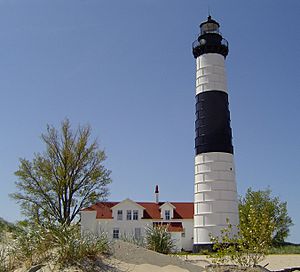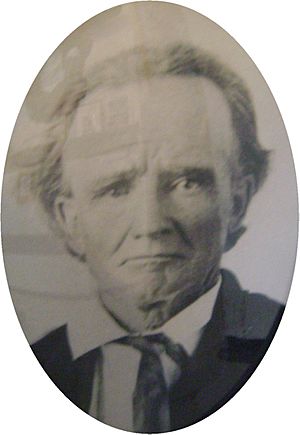Big Sable Point Light facts for kids
 |
|
| Big Sable Point Lighthouse | |
|
|
|
| Location | Ludington, Michigan |
|---|---|
| Coordinates | 44°03′27.8″N 86°30′52″W / 44.057722°N 86.51444°W |
| Year first constructed | 1867 |
| Year first lit | 1867 |
| Automated | 1968 |
| Foundation | Wood pilings |
| Construction | originally Cream City brick, later encased in cast iron plate |
| Tower shape | Frustum of a Cone |
| Markings / pattern | White and black tower/Black parapet & Lantern |
| Height | 112 feet (34 m) |
| Focal height | 106 feet (32 m) |
| Original lens | Third order Fresnel lens |
| Current lens | 12-inch (300 mm) ML-300 Tideland Signal acrylic optic |
| Range | 15 nautical miles (28 km; 17 mi) |
| Characteristic | White, fixed light. Obscured from 238° to 346°. |
| ARLHS number | USA-054 |
The Big Sable Point Light is a famous lighthouse on the eastern shore of Lake Michigan. It stands near Ludington in Mason County, Michigan. You can find it inside the Ludington State Park. This lighthouse is still active today, helping ships navigate the waters.
Contents
What is the Big Sable Point Light?
The Big Sable Point Light is a tall tower with a bright light at the top. It guides boats safely along the coast. This area was once very dangerous for ships. Many ships wrecked here before the lighthouse was built. The lighthouse helps prevent accidents by showing sailors where the land is.
Building the Lighthouse
In 1866, the U.S. government decided to build a lighthouse at Big Sable Point. They set aside $35,000 for the project. Michigan gave the land to the U.S. government for free. Construction began in early 1867. This made it the first lighthouse in this part of Michigan.
The tower was finished in 1867. It was originally 112 feet (34 m) tall. It was made of yellow bricks called "Cream City Brick." These bricks were not strong enough for the weather. They started to wear down over time.
Getting building materials to the site was hard. They had to bring everything by ship. The first road to the lighthouse was not built until 1933.
Changes Over Time
Because the original bricks wore out, the tower was covered with steel plates in 1900. This cost $3,225. The yellow bricks were hidden by the steel. The lighthouse needed a new look so ships could easily spot it during the day.
Over the years, the lighthouse's colors changed. Today, the tower is white with a black top. It also has a black band around the middle. Old pictures show it was once red and white, and later black and white.
The Big Sable Point Light was one of the last lighthouses on the Great Lakes to get modern updates. It finally got electricity and indoor plumbing in the late 1940s.
The original light was a special "third order Fresnel lens." This type of lens made the light very powerful. It was removed in 1985. You can now see it at the Rose Hawley Museum.
Who Kept the Light?
For many years, a lighthouse keeper and their family lived at the lighthouse. Their job was to keep the light burning and the equipment working. They were very important for the safety of ships.
Some of the early lighthouse keepers included Alonzo Hyde, Sr. (1867–1869) and Alonzo W. Hyde (1869–1871). Many other dedicated people worked there over the years. The last keeper was Homer Meverden, who served until 1968.
In 1949, the lighthouse got electricity. This was a big change. It meant the light no longer needed wicks or oil. This step led to the lighthouse becoming automated. When a lighthouse is automated, it means machines do the work. This ended the need for a human lighthouse keeper.
The lighthouse also had a fog horn. This loud signal helped ships find their way in foggy weather. The fog horn building fell into the lake in 1943 because of erosion.
Visiting the Lighthouse Today
The Big Sable Point Lighthouse is a historic site. It was added to the list in 1983. It is also a Michigan State Historic Site.
The lighthouse is now owned by the state of Michigan. The Sable Points Light Keepers Association helps take care of it. This group works hard to keep the lighthouse and its buildings in good shape.
You can visit the lighthouse! It is located inside Ludington State Park. You will need a vehicle permit to enter the park. From the park entrance, you can walk about 1.5 miles (2.4 km) to reach the lighthouse. You can walk along the beach or use a hiking trail.
Sometimes, a bus is available to take visitors from the park to the lighthouse. There is a small fee for the bus ride. You can also climb the tower for a small fee. The lighthouse has a gift shop and a video room that are free to visit.
The Sable Point Light Keepers Association has a special program. Volunteers can live and work at the lighthouse for two weeks. This helps keep the lighthouse running and lets people experience what it was like to be a keeper.



